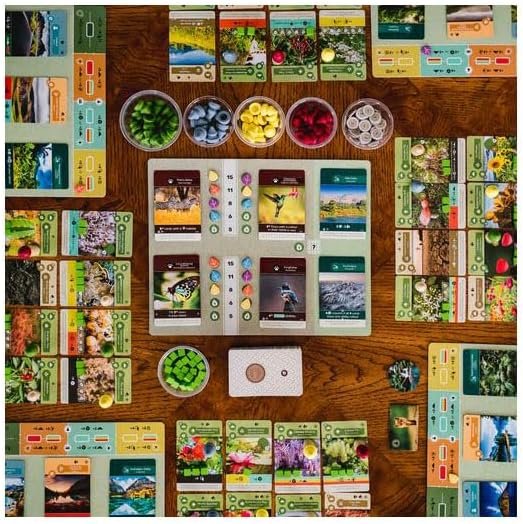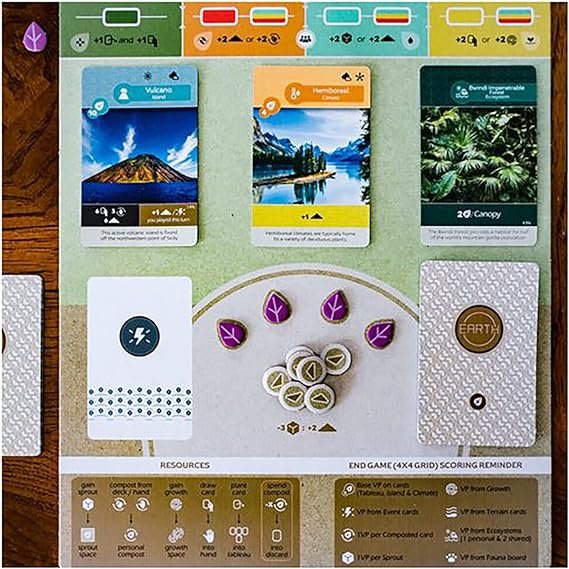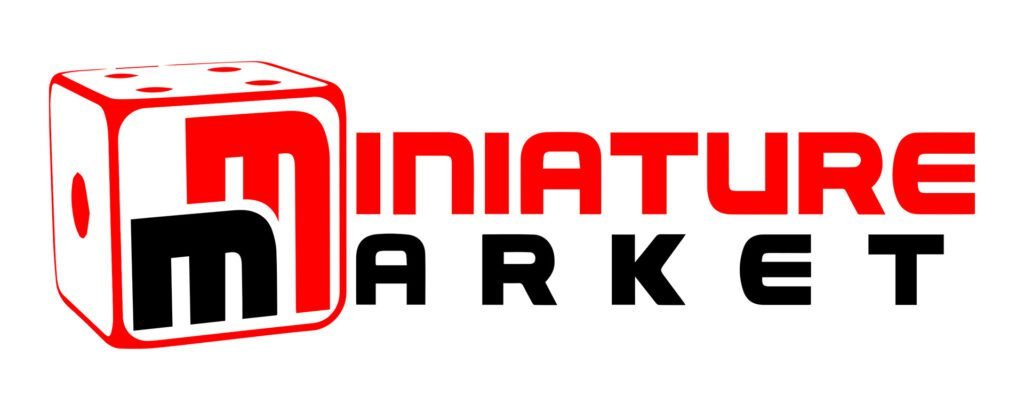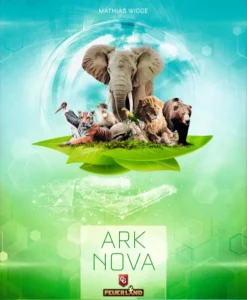
Today we’re diving into “Earth.” This is a board game from Inside Up Games that transports you into a vibrant ecosystem where you’ll nurture & expand habitats, striving for a harmonious balance with nature. So, let’s break it down – what it is, what’s good, what’s bad, & if you should pick it up. Let’s get into it.

What It Is
“Earth” is an engine-building game designed by Maxime Tardif. It’s a game for 1-5 players that typically lasts between 45 to 90 minutes. The premise is straightforward yet captivating: you’re cultivating a thriving habitat by carefully managing resources & species to create a sustainable & diverse ecosystem. The game’s theme is deeply integrated, from its stunning artwork to its intricate mechanics, making it a standout in its genre.

Gameplay Mechanics
In Earth, players create personal habitats by constructing a 4×4 grid of cards that represent various flora & terrains. Each card has unique powers that activate during the game. Some cards provide immediate effects, but most offer repeatable abilities triggered by specific player actions. Selecting cards with complementary powers & maximizing their activation is essential for an effective strategy.
Players use soil resources to play cards from their hands onto their tableaux. Once in play, these cards can be nurtured by watering to generate sprouts, adding growth tokens, or discarding cards to the compost pile. The compost pile is a valuable resource for generating more soil or meeting card requirements.
The goal is to accumulate the highest number of victory points, which can be earned through various means. Cards have inherent victory point values scored at the end, & players can gain points by filling growth & sprout spaces on their cards. Some cards offer bonus points based on the tableau’s arrangement & composition. Players also aim to achieve four public objectives & one private objective for substantial points. Every card discarded to the compost pile adds to the final score.
The game features four main actions, each with a distinct color & icon. On their turn, the active player selects one action, & all other players execute the same action with potential variations based on their card abilities & bonuses.
- Plant Action: The active player can play up to two cards from their hand onto their tableau, paying the soil costs. Non-active players may play one card.
- Compost Action: The active player gains 5 soil & places two cards from the deck into their compost pile. Non-active players gain less soil & compost fewer cards.
- Water Action: The active player can place up to six sprout cubes on cards with available spaces & gains two soil. Non-active players gain fewer sprouts & soil.
- Growth Action: The active player draws four cards & places two growth tokens on cards with available spaces. Non-active players draw fewer cards & place fewer tokens.
After the main action, players activate the abilities of cards matching the action’s color. If the Growth action (yellow) is selected, all players activate yellow abilities on their cards. Some cards may have multiple action colors, allowing additional activations. This step is simultaneous for all players, ensuring smooth gameplay.
The game ends when a player completes their 4×4 tableau by playing their 16th card, earning a 7-point bonus. Players then tally their scores from growth cubes, sprout tokens, composted cards, & fulfilled objectives. The player with the highest score wins, having cultivated the most prosperous habitat.

The Components
The components of “Earth” are nothing short of a visual treat. The game features beautiful artwork by M81 Studio & others, with cards depicting a vibrant array of species & habitats. The quality of the components, from the linen-finished cards to the sturdy game boards, ensures a durable & enjoyable experience. The insert is well-designed, making setup & teardown smooth, & the 3D growth stacks & sprout cubes add a tactile element that enhances the overall aesthetic.
The Good
First off, the theme & components are a major highlight. The nature-based theme is refreshing, with artwork & components that bring the game to life. The simultaneous play mechanics minimize downtime, keeping all players engaged throughout the game, which is especially beneficial in larger groups.
The gameplay is smooth & intuitive, with simple rules that make it easy to teach & quick to pick up. Despite its simplicity, “Earth” offers a variety of strategic options, allowing for flexibility & creativity in how you approach the game. The dynamic tableau arrangement means that no two games will play out the same way, giving the game strong replayability.
The Bad
The game’s length, while shorter than some engine builders, can feel a bit stretched given the nature of the gameplay. Starting without initial Ecosystem & Climate cards can make early turns feel less impactful, which slightly detracts from the experience. The game’s minimal player interaction might also be a downside for those who prefer more direct competition in their games. “Earth” leans heavily into a multiplayer solitaire experience, which can feel a bit solitary.
Additionally, the sheer number of cards can be overwhelming, & some of the smaller components can be fiddly to handle, which might detract from the overall experience. While the game is reasonably priced, it might not deliver the same thrill or urgency as other engine builders due to its laid-back nature.
The Verdict
So, should you buy “Earth”? If you’re a fan of engine-building games or appreciate a nature-themed experience, “Earth” is a solid addition to your collection. It’s an excellent game for introducing new players to more serious board games, thanks to its smooth mechanics & engaging gameplay. The components & theme are top-notch, making it a visually & tactically appealing game.
However, if you prioritize player interaction & social dynamics in your games, “Earth” might feel a bit too solitary. It’s a peaceful, puzzle-like experience that’s more about personal strategy than outmaneuvering your opponents. Despite its few shortcomings, “Earth” is a must-try for anyone who enjoys strategic, low-downtime games with plenty of variety & replayability.

Final Thoughts
Earth excels in its theme & components. The nature & plant-based theme is refreshing & visually appealing, with high-quality components that enhance the gaming experience. The 3D pieces, such as the growth stacks & sprout cubes, add a tactile element that literally elevates the game. While some might prefer traditional artwork over the photography used on the cards, I found it fitting & consistent with the theme.
The gameplay mechanics are smooth & intuitive. The rules are straightforward, making it easy to teach & quick to pick up. This simplicity doesn’t come at the expense of depth, though. Earth offers a variety of strategic options, from focusing on composting to building a diverse ecosystem. The dynamic tableau arrangement allows for flexibility & creativity, which keeps the game engaging over multiple plays.
One of the game’s standout features is its simultaneous play. This design choice minimizes downtime, ensuring all players are engaged throughout the game. This aspect is particularly appealing in larger groups where waiting for turns can often drag. Additionally, the actions are well-balanced & satisfying, particularly as your engine builds & you trigger more powerful combinations later in the game.
However, Earth isn’t without its flaws. The game length, while shorter than some contemporaries like Terraforming Mars or Ark Nova, can still feel a bit stretched given the nature of the gameplay. Starting without the initial Ecosystem & Climate cards can make the early turns feel scripted & less impactful, which is a minor but noticeable drawback. The game might have benefited from incorporating these cards into the starting setup to jumpstart the action.
Another point of contention is the game’s extreme lack of player interaction. Earth is essentially a multiplayer solitaire experience, which can be both a strength & a weakness. For those who enjoy a peaceful, solitary puzzle, this is ideal. However, if you thrive on direct competition or social interaction, Earth may feel lacking. This also makes it a less thrilling choice for those who seek excitement from player dynamics & strategic interference.
Lastly, the sheer number of cards can be overwhelming, & the small, fiddly components can be annoying to handle, detracting slightly from the overall experience. Additionally, while the game is reasonably priced for its content, it may not deliver the same thrill or urgency as some other engine builders due to its laid-back, solitary nature.
In conclusion, Earth is a solid recommendation for fans of engine-building games & those who appreciate a nature theme. It’s an excellent choice for introducing players to more serious board games due to its smooth mechanics & engaging gameplay. However, if you prioritize player interaction & social elements in your board games, you might find Earth a bit too solitary. Despite its few shortcomings, Earth is a must-try for anyone who enjoys strategic, low-downtime games with plenty of variety & replayability.
Purchase Options


At no extra cost to you, The Board Game Site may receive revenue from affiliate and advertising partnerships for sharing this content and from purchases through links.








